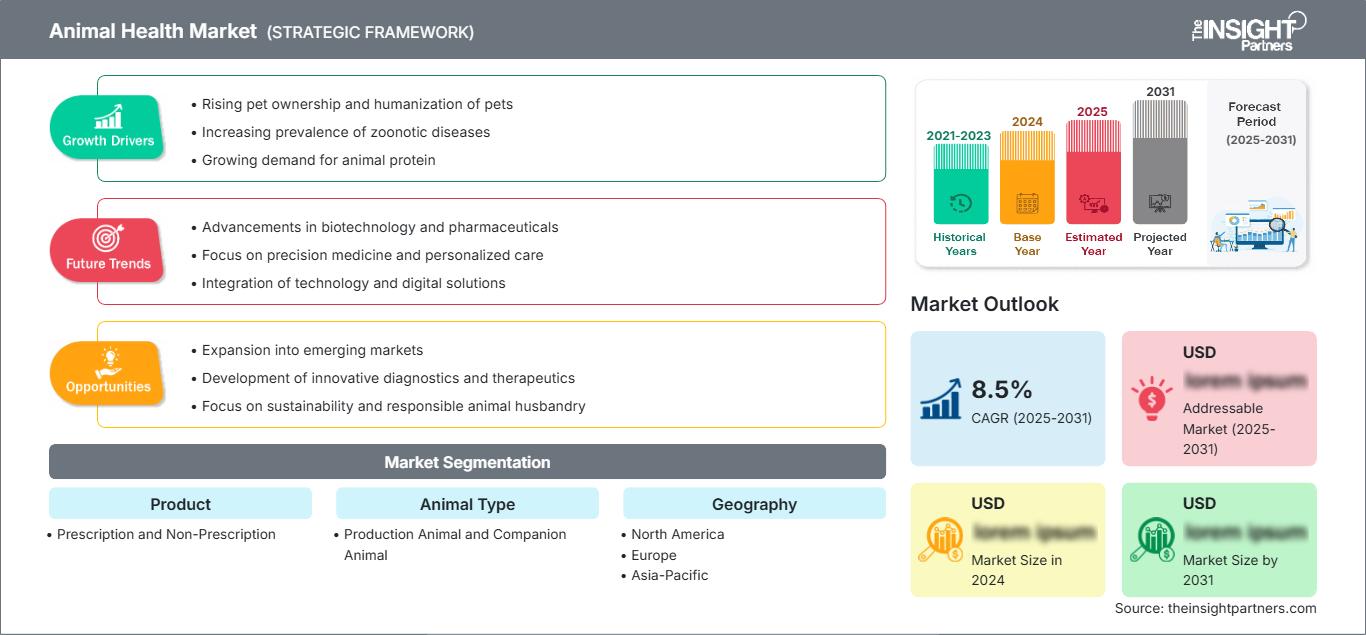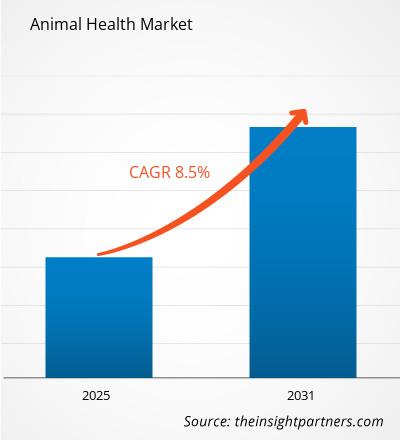Der Markt für Tiergesundheit wird bis 2031 voraussichtlich ein Volumen von 144,15 Milliarden US-Dollar erreichen. Für den Zeitraum 2025–2031 wird ein jährliches Wachstum von 6,8 % erwartet.
Der Bericht ist in zwei Abschnitte unterteilt: Produkt (verschreibungspflichtig und nicht verschreibungspflichtig) und Tierart (Nutztiere und Haustiere). Die globale Analyse ist nach Regionen und wichtigen Ländern aufgeschlüsselt. Die Marktbewertung für die oben genannte Segmentanalyse wird in US-Dollar dargestellt. Der Bericht „Tiergesundheitsmarkt“ von The Insight Partners beschreibt die aktuelle Marktlage und das zukünftige Wachstum sowie die wichtigsten Triebkräfte, Herausforderungen und Chancen. Dies wird verschiedenen Geschäftspartnern Einblicke bieten, wie zum Beispiel:
- Technologieanbieter/Hersteller: Um die sich entwickelnde Marktdynamik zu verstehen und potenzielle Wachstumschancen zu erkennen, damit sie fundierte strategische Entscheidungen treffen können.
- Investoren: Um eine umfassende Trendanalyse hinsichtlich der Marktwachstumsrate, der Finanzprognosen und der Chancen entlang der Wertschöpfungskette durchzuführen.
- Regulierungsbehörden: Um Richtlinien zu regulieren und Aktivitäten auf dem Markt zu überwachen, mit dem Ziel, Missbrauch zu minimieren, das Vertrauen der Investoren zu wahren und die Integrität und Stabilität des Marktes zu gewährleisten.
Segmentierung des Tiergesundheitsmarktes: Produkt
- Verschreibungspflichtige und nicht verschreibungspflichtige Produkte
Tierart
- Nutztiere und Haustiere
Sie erhalten kostenlos Anpassungen an jedem Bericht, einschließlich Teilen dieses Berichts oder einer Analyse auf Länderebene, eines Excel-Datenpakets sowie tolle Angebote und Rabatte für Start-ups und Universitäten.
Tiergesundheitsmarkt: Strategische Einblicke

-
Holen Sie sich die wichtigsten Markttrends aus diesem Bericht.Dieses KOSTENLOSE Beispiel umfasst Datenanalysen, die von Markttrends bis hin zu Schätzungen und Prognosen reichen.
Wachstumstreiber im Tiergesundheitsmarkt
- Zunehmende Haustierhaltung und Vermenschlichung von Haustieren: Immer mehr Menschen halten Haustiere, behandeln sie wie Familienmitglieder und investieren in ihre Gesundheitsversorgung.
- Zunehmende Verbreitung von Zoonosen: Krankheiten, die zwischen Tieren und Menschen übertragen werden können, nehmen zu und erhöhen den Bedarf an Maßnahmen zur Tiergesundheit.
- Steigende Nachfrage nach tierischem Eiweiß: Die Weltbevölkerung wächst, was zu einer höheren Nachfrage nach Fleisch- und Milchprodukten und damit zu einem höheren Bedarf an gesunden Nutztieren führt.
Zukünftige Trends im Tiergesundheitsmarkt
- Fortschritte in der Biotechnologie und Pharmazie: Neue Technologien führen zu effektiveren Impfstoffen, Diagnostika und Behandlungen für Tierkrankheiten.
- Fokus auf Präzisionsmedizin und personalisierte Pflege: Behandlungen werden individuell auf die Bedürfnisse und die genetische Ausstattung der Tiere abgestimmt. Integration von Technologie und digitalen Lösungen: Einsatz von Technologie für Bereiche wie Fernüberwachung, Telemedizin und Datenanalyse zur Verbesserung der Tierversorgung.
Marktchancen im Bereich Tiergesundheit
- Expansion in Schwellenländer: Viele Entwicklungsländer verzeichnen wachsende Tierpopulationen und eine steigende Nachfrage nach Tiergesundheitsprodukten und -dienstleistungen.
- Entwicklung innovativer Diagnostika und Therapeutika: Entwicklung neuer und verbesserter Instrumente zur Diagnose und Behandlung von Tierkrankheiten.
- Fokus auf Nachhaltigkeit und verantwortungsvolle Tierhaltung: Förderung des Tierschutzes, Reduzierung der Umweltauswirkungen der Tierhaltung und Gewährleistung eines verantwortungsvollen Antibiotikaeinsatzes.
Markt für Tiergesundheit
Die regionalen Trends und Einflussfaktoren auf den Tiergesundheitsmarkt im gesamten Prognosezeitraum wurden von den Analysten von The Insight Partners ausführlich erläutert. Dieser Abschnitt behandelt außerdem die Marktsegmente und die geografische Verteilung des Marktes für das Management von Herzrhythmusstörungen in Nordamerika, Europa, Asien-Pazifik, dem Nahen Osten und Afrika sowie Süd- und Mittelamerika.
Umfang des Marktberichts zum Thema Tiergesundheit
| Berichtsattribut | Einzelheiten |
|---|---|
| Marktgröße in 2024 | US$ XX Billion |
| Marktgröße nach 2031 | US$ 144.15 Billion |
| Globale CAGR (2025 - 2031) | 6.8% |
| Historische Daten | 2021-2023 |
| Prognosezeitraum | 2025-2031 |
| Abgedeckte Segmente |
By Produkt
|
| Abgedeckte Regionen und Länder |
Nordamerika
|
| Marktführer und wichtige Unternehmensprofile |
|
Dichte der Marktteilnehmer im Bereich Tiergesundheit: Auswirkungen auf die Geschäftsdynamik
Der Markt für Tiergesundheit wächst rasant, angetrieben durch die steigende Nachfrage der Endverbraucher. Gründe hierfür sind unter anderem sich wandelnde Verbraucherpräferenzen, technologische Fortschritte und ein wachsendes Bewusstsein für die Vorteile der Produkte. Mit steigender Nachfrage erweitern Unternehmen ihr Angebot, entwickeln innovative Lösungen für die Bedürfnisse der Verbraucher und nutzen neue Trends, was das Marktwachstum zusätzlich beflügelt.

- Holen Sie sich die Tiergesundheitsmarkt Übersicht der wichtigsten Akteure
Wichtigste Verkaufsargumente
- Umfassende Abdeckung: Der Bericht bietet eine umfassende Analyse der Produkte, Dienstleistungen, Typen und Endnutzer des Tiergesundheitsmarktes und vermittelt so ein ganzheitliches Bild.
- Expertenanalyse: Der Bericht basiert auf dem fundierten Wissen von Branchenexperten und Analysten.
- Aktuelle Informationen: Der Bericht gewährleistet Geschäftsrelevanz durch die Berücksichtigung aktueller Informationen und Datentrends.
- Anpassungsmöglichkeiten: Dieser Bericht kann an spezifische Kundenanforderungen angepasst werden und sich optimal in die Geschäftsstrategien integrieren.
Der Forschungsbericht zum Tiergesundheitsmarkt kann somit maßgeblich dazu beitragen, das Branchenszenario und die Wachstumsaussichten zu entschlüsseln und zu verstehen. Auch wenn einige berechtigte Bedenken bestehen, überwiegen die Vorteile dieses Berichts insgesamt die Nachteile.
- Historische Analyse (2 Jahre), Basisjahr, Prognose (7 Jahre) mit CAGR
- PEST- und SWOT-Analyse
- Marktgröße Wert/Volumen – Global, Regional, Land
- Branchen- und Wettbewerbslandschaft
- Excel-Datensatz
Aktuelle Berichte
Verwandte Berichte
Erfahrungsberichte
Grund zum Kauf
- Fundierte Entscheidungsfindung
- Marktdynamik verstehen
- Wettbewerbsanalyse
- Kundeneinblicke
- Marktprognosen
- Risikominimierung
- Strategische Planung
- Investitionsbegründung
- Identifizierung neuer Märkte
- Verbesserung von Marketingstrategien
- Steigerung der Betriebseffizienz
- Anpassung an regulatorische Trends






















 Kostenlose Probe anfordern für - Tiergesundheitsmarkt
Kostenlose Probe anfordern für - Tiergesundheitsmarkt